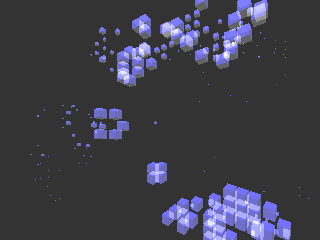International
Conference on Auditory Display, Kyoto, July 2002
Liquiprism
- Generating Polyrhythms
with Cellular Automata
Alan
Dorin
http://www.csse.monash.edu.au/~aland
Centre for Electronic
Media Art
School of Computer Science & Software Engineering
Monash University, Melbourne, Australia
Outline
- Motivation
- Previous methods & music
- Cellular Automata
|
- Liquiprism as it is
- Liquiprism as it is becoming
- Conclusions
|
Motivation (personal)
Previous music
- Xenakis: Pleiades
- Reich: Drumming, Music for 18 Musicians, Sextet...
- Autechre: ep7
- Plastikman: Artifakts
- Jazz & Cuban, African, Chinese or Hindu percussion music
...exploit polyrhythmic structures for their 'spark'
Previous / related methods
- Play it
(multiple players, hands, mallets or fingers)
- Mechanize it
(tape recorders, metronomes, clocks, revolving arms, suspended microphones)
- Compute it (electronic sequencers, "ordinary" cellular automata,
complex systems)
 |
 |
|
Two one dimensional CA's, Wolfram '84
|
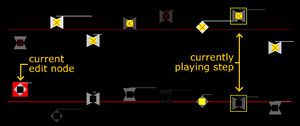 |
|
Boolean Sequencer, Dorin '99
|
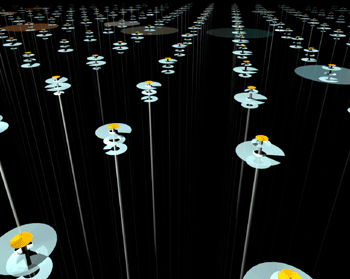 |
|
Turbulence (detail), McCormack '94*
|
Cellular Automata
- Connected set of finite state-machines (usually arranged in a square grid).
- Synchronous update.
- A node's future state depends on the states of nodes in the network designated
as its neighbours and its transition rule/table.
|
|
|
| 4 - neighbourhood region |
8 - neighbourhood region |
- A node may read/feedback its own state as a self-input.
Sample Cellular Automata: The
Game of Life
- 8 neighbours for each cell
- 2 states per cell (ON/OFF)
|
Transition rules
|
|
|
if (current-state ON)
if (exactly 2 or 3 neighbours ON)
{ next-state ON }
else
{ next-state OFF }
|
else // current-state OFF
if (exactly 3 neighbours ON)
{ next-state ON }
else
{ next-state OFF }
|
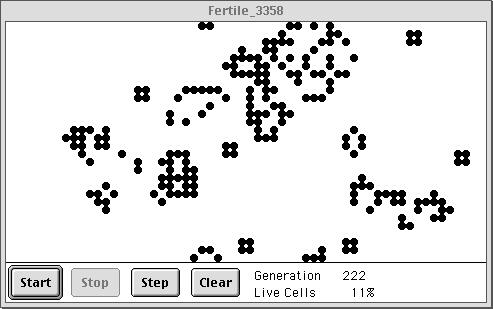
Screenshot from Easy Life v2.0 by Reggie McLeod
Sample cyclic patterns

|

|

|

|
|
Spinner (animated) |
1 |
2 |
1 |
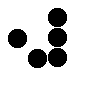
|
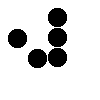
|
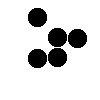
|
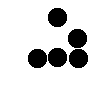
|
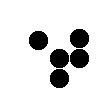
|
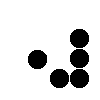 |
|
Glider (animated) |
1 |
2 |
3 |
4 |
1 |
Liquiprism
- Set of 6 cellular automata grids arranged in a cube
- Neighbours to a cell may cross cube edges
- Cube faces may operate under different transition rule sets
- Active nodes trigger MIDI events (2 are selected from a larger number)
- Cube faces are assigned different MIDI channels
- Pitches rise a semi-tone for one grid space across a face, and a fifth for
one step up a face
|
Transition rules (set #1)
|
|
|
if (current-state ON)
if (exactly 2 or 3 neighbours ON)
{ next-state ON }
else
{ next-state OFF }
|
else // current-state OFF
if (>= 4 neighbours ON)
{ next-state ON }
else
{ next-state OFF }
|
|
Transition rules (set #2)
|
|
|
if (current-state ON)
as above
|
else // current-state OFF
if (neighbour-below ON) AND (1in3 chance)
{ next-state ON }
else
{ next-state OFF }
|
User Interface - Current
- Simple mouse-based rotation of the cube
- Random activation of the cells on the front face triggered by mouse clicks
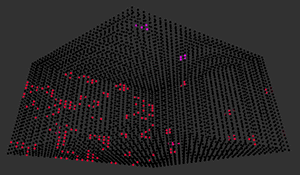 |
| Current
interface |
|
|
User Interface - Under development
- Sculptural prism of light
- Activation of the cells on the faces according to position and movement
of visitors to the installation
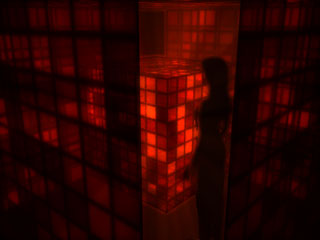 Interface under development
Interface under development |
|
| |
Conclusions
- As a music or polyrhythm generator this is 'OK' but not great
- As a screen-based interactive it is of limited interest as it does not seem
to have a strong 'presence'...
- Perhaps it:
- Requires a more interactive approach to response and control
- Requires a physical form which can be experienced without the (apparent)
barrier of the screen
©Copyright Alan
Dorin/Animaland 2002
(*Turbulence image © Copyright
Jon McCormack 1994-2002)





